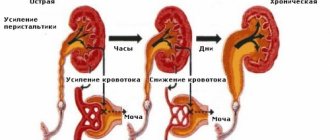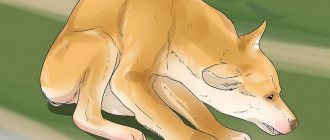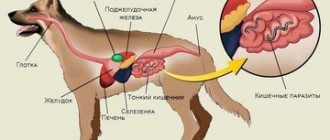The ability to move and perform simple actions is ensured by the coordinated work of the brain, spinal cord, nerves and muscles. This complex communication system works like this: nerves in the brain send signals about the environment to the body, and the body in turn sends signals to the brain. Signals are transmitted through the spinal cord nerves located in the spinal column. Thus, the nerves of the brain and the nerves of the spinal cord form the human central nervous system. Injury to any part of the nervous system can lead to disruption of communication or complete loss of communication between the brain and body, which in turn leads to the inability of the brain to control body movements.
Loss of the ability to move in dogs
The spinal column consists of 24 vertebrae and is called the spine. The vertebrae are separated from each other by small spacers - intervertebral discs. The spine and intervertebral discs protect the spinal cord from damage. Injury to the spine or intervertebral discs can threaten the nerves of the spinal cord
and lead to further damage to the nervous system.
A condition called paralysis
occurs due to disruption of the connection between the spinal cord and the brain. There are two conditions: paralysis, which is a complete inability to move the limbs, and paresis or partial paralysis, in which the connection between the brain and the spinal cord still exists, allowing the limbs to move. In some cases, all four limbs are paralyzed (tetraplegia), and in some cases, part of the limbs retains sensitivity. This depends on the location of the damage that affected the functioning of the brain, spinal cord, nerves and muscles.
Some dog breeds are more susceptible to spinal injuries than others.
For example, short dogs with long backs, such as the dachshund or basset hound, often suffer from herniated discs, which put pressure on the spinal cord.
There is also a genetic predisposition of some dog breeds
to degenerative myelopathy, a disease that affects the nerves in the spinal cord in older dogs (over 7 years of age).
This disease progresses slowly and leads to paralysis of the hind limbs. The breeds most susceptible to degenerative myelopathy are Welsh Corgi, Boxer, German Shepherd, Chesapeake Bay Retriever and Irish Setter.
Provoking factors of paralysis
Below are the provoking factors that enhance and stimulate the development of paralysis in dogs. Some of them are the root cause, while others only “push” the emergence of pathology.
From a tick bite
After a tick bite, paralysis occurs, but the tick itself has nothing to do with it. The root cause is blood parasitic diseases, which are carried by these parasites. In advanced cases, they can cause complications in the form of paralysis.
Poisoning
Not every poisoning can lead to the development of paralysis. Typically, this result is a consequence of the ingestion of heavy metal salts, toxins of certain plants, poisons of snakes, insects, or “exotics” into the dog’s body, such as the poisons of shellfish or poisonous tropical fish. As a rule, after the removal of these compounds, the animal recovers and the functionality of the organs is completely restored... But more often the dog dies long before this, from paralysis of the respiratory muscles or fatal functional damage to the central nervous system.
Stroke
Cerebral hemorrhage, that is, stroke, also happens in dogs. Characterized by severe organic brain damage. This pathology is characterized by complete or bilateral paralysis. The condition of animals after a stroke is extremely difficult; complete restoration of functions is almost impossible.
Injury
As we have written many times, trauma is the main cause of many cases of paralysis. Most often this is:
- Severe limb fractures.
- Damage to the spine (especially the thoracic and sacral regions).
- Traumatic brain injuries.
- Gunshot wounds in working and hunting dogs.
- Deep bite wounds, etc.
Diagnostics
It is important to describe in detail to the veterinarian the dog's condition, the nature and duration of the symptoms, as well as any cases that could have caused the paralysis, such as a tick bite, a fall or an unsuccessful jump. During the examination, the veterinarian will pay special attention to how the animal's limbs move and check reflexes. It is also necessary to test everyone's sensitivity to pain.
four paws, head and back.
This will help the veterinarian determine where exactly the problem occurred. Standard laboratory tests,
such as complete blood counts, biochemical tests, and urinalysis, can help identify bacterial, viral, or toxic infections affecting the nervous system. An X-ray of the spine will show possible vertebral pathologies or herniated discs putting pressure on the spinal cord. X-rays are also used to detect other pathologies that can lead to disruption of the nervous system, such as tumors, blockages or inflamed nerves. In some cases, a special type of x-ray is required - a myelogram. This procedure involves injecting a specially colored fluid into the spinal cord to produce a more detailed image of the spine on X-rays. If x-rays are not enough, it is necessary to additionally do a computed tomography or magnetic resonance imaging (MRI) of the brain and spinal cord to obtain a detailed image of them, more detailed than on x-rays. Sometimes a biopsy of muscle, nerve fibers, and cerebrospinal fluid is needed to perform a laboratory test to determine if there is an infection in the brain or spinal cord.
Treatment
Treatment directly depends on the cause of paralysis.
If your dog is unable to walk or relieve himself on his own, the best solution is to hospitalize him.
Once the diagnosis is made, the veterinarian will prescribe a course of treatment and will be able to monitor the animal’s condition daily. If your dog is in pain, he will be prescribed painkillers. Daily dog care involves emptying the bladder using a catheter and regularly changing body position to prevent bedsores. If the cause of paralysis is an infection or a herniated disc, treatment may be medication, or surgery or physical therapy will be required. Anti-inflammatory drugs are prescribed to relieve nerve inflammation. Tumors and blood supply blockages are removed surgically
if their location allows. Some paralyzed dogs recover quickly. Depending on the severity of the dog's condition, he will either have to be left in the clinic until he can move independently, or he will have to be taken home with the necessary instructions from the veterinarian on how to care and treat the animal at home. In any case, the dog will need to be shown to the veterinarian regularly so that he can adjust the course of treatment.
Your veterinarian will help you create a care plan for your pet. The dog may react aggressively to treatment at first
because of the pain experienced, however, patient handling and your persistence will help in the future to rid the animal of fear. Have someone hold your dog while you perform the necessary procedures, or simply swaddle your pet so that he does not roll around and interfere with your care.
Proper care is very important for your four-legged friend's recovery. Follow your veterinarian's instructions carefully. If he prescribed medications to the dog, then it is necessary for it to take the full course. Even if it seems to you that the animal’s condition has improved, do not stop giving your dog medications until the course of treatment is completed. Never give painkillers or other drugs to your dog.
without prior consultation with a veterinarian. Remember that some medications can be harmful to your pet. In cases where paralysis cannot be cured, but the dog is otherwise completely healthy, the best solution is to purchase a special mobility aid for paralyzed dogs so that the animal can move independently. Most dogs quickly get used to this device and continue to live a full life. It is best to have a paralyzed dog neutered or spayed to avoid the risk of further injury during mating.
We love to watch our pets jump and enjoy life, running around the house or green lawn. But in cases where the dog lies motionless, cannot get up, does not eat, does not drink, and does not even defecate, the sight becomes not so pleasant. Do not delay calling the veterinarian - your pet may have paresis. It is fraught with serious consequences, including complete paralysis and death (which, in principle, is better than the vegetable state).
By “paresis” we mean a pathology similar to paralysis:
limbs do not work, the sensitivity of their skin is impaired. But still there are certain differences. So, with paresis, some ability to move is still retained, and the sensitivity of the skin does not disappear anywhere (except for the most severe cases).
What is the reason for such a severe pathology? Firstly, severe injuries.
If your dog has recently been hit by a car or the animal's skin shows signs of severe beatings, the likelihood of spinal damage is quite high. The insidiousness of this type of injury is that it may not appear immediately.
Let's assume that after a blow or fall, cracks appear on the vertebrae(s).
If they are not too large and the dog leads at least a relatively quiet life, one can hope that they will heal over time. In cases where the animal is active, runs a lot and quickly, or (what is much worse) it gets hit by a bicycle again/falls, fragments may break off from the bone. When they are large and the force of impact is great, the pieces of bone will almost certainly damage the spinal cord so that the animal is paralyzed.
Traditional methods
Wolves and wild dogs seek their salvation in medicinal herbs and plants. Does this mean that herbal medicine is a completely natural procedure for dogs?
The fact is that traditional medicine is extremely unreliable. Many recipes are based only on coincidences and speculation. Just because a method worked for one dog doesn't mean it will work for yours.
Do not self-medicate and do not waste time looking for a miraculous decoction - paralysis is the case when delay can be fraught with the death of the dog.
Other causes
The veterinary literature describes situations where gradual numbness of the body, associated with severe disturbances of water-salt metabolism, developed in dogs suffering from severe forms of exhaustion.
Hypothetically, this could happen to a stray animal or a dog whose owners have fed low-quality dry food all its life.
But more often postpartum paresis in dogs develops in a similar way. This is an extremely serious condition that develops in bitches who have just given birth. In rare cases, paresis can “overtake” an animal on the third or fourth day after the birth of the offspring. The pathology develops against the background of a serious lack of calcium in the body, which disrupts the transmission of neuromuscular impulses.
But do not forget about other probable reasons. As well as complete paralysis, bladder paresis
(and other organs) can develop against the background of cancer. When a tumor grows on the surface of the spinal column or directly in the spinal canal, it compresses the surface of the spinal cord. Light compression causes paresis. If the mechanical pressure is strong, or it continues for a sufficiently long time, the nervous tissue atrophies and the animal becomes paralyzed.
Prevention
Considering the nature of the neurological and orthopedic root causes of paralysis, as such, complete prevention, unfortunately, does not exist.
Of course, you should always protect your pet as much as possible from injuries, jumps and falls from heights, and always feed him fresh, dog-friendly food or food. Avoid excess protein, control the dosage of calcium in the diet to avoid deficiency, and regularly treat your pet with anti-tick drops and sprays.
For any symptoms of paralysis, your task is to deliver the dog to the clinic as soon as possible. It is rarely possible to predict the rate of neuronal destruction, and quite often the favorable prognosis will directly depend on the speed of your reaction and timely assistance provided.
Until now, veterinary medicine continues to classify diseases of the peripheral nervous system (PNS) in domestic animals. The main PNS disorders in domestic animals are degenerative in nature, usually have a breed predisposition and are congenital and hereditary. Inflammatory and infectious neuropathies are also well known in dogs and cats. This article provides an overview of the clinical and pathological findings of a rare demyelinating inflammatory neuropathy of which only a few previous reports exist.
Clinical picture of the disease
In severe cases (when the spinal cord is damaged), the clinical signs are quite characteristic. Let's list the most obvious ones:
- The pet's hind (usually) limbs are taken away.
With a relatively light flow, the animal can move them a little, but does not feel pinches, jolts, injections, etc. at all.
- Again, with severe pathology, a serious decrease in overall body temperature
(hypothermia) is possible. This is not very typical for traumatic paresis, but for the postpartum variety the course is very typical.
-
, muscle twitching, and abnormal neck bending may occur
- When the spinal cord is damaged, the pet may suffer from panic attacks
, bulging eyes, and the dog whines.
- There is no appetite
, no thirst, depending on the severity of the case.
It should also be understood that the symptoms of paresis in dogs depend on the location of the spinal cord injury, as well as on which parts of the spinal cord are “switched off.” So, with paresis of the bladder, the animal cannot urinate, no matter how much it strains. Moreover, unlike cases of ureteral blockage/squeezing, urine is not released at all - there is no trace of it, no smell. The pet's belly quickly hardens and becomes tense. If a catheter is not installed, the dog will most likely die from a ruptured bladder.
Paralysis in dogs is characterized by disruption of connections between the spinal cord and brain. Coordination of movements is impaired. The dog may completely lose the ability to move.
Let's look at the reasons why paralysis occurs. In what places does paralysis occur? Is there an effective treatment against paralysis?
Treatment of dogs
Therapeutic measures depend on the underlying cause of paralysis. If the disease is infectious, the veterinary specialist’s efforts will be aimed at suppressing pathogenic microflora in the body. In the event that the cause of a neurological disease is destructive processes in the spinal column, a violation of the integrity of the vertebrae due to injury, the use of novocaine blockades is effective.
A good result is achieved by a course of therapy with glucocorticosteroids (dexamethasone, prednisolone), B vitamins. For pain relief, antispasmodics are used - No-shpa, Spazgan, Baralgin.
In some cases, veterinary practice resorts to surgical treatment. If the cause of paralysis is injury to the vertebrae or tumors, then surgical intervention is possible.
When treating dogs with paralysis, the owner should be aware of the risk of complications such as bedsores, hypostatic pneumonia, etc.
For your information
In order for a dog to make certain movements, there needs to be coordination in the work between the brain, spinal cord, nerves, and muscles. Nerve endings in the brain give signals to the muscles.
The muscles transmit the signal back. All signals pass through the vertebral column of the spinal cord. When an injury occurs to any part, the connection between the brains is disrupted and coordination is lost.
Symptoms
With paralysis, the following symptoms can be observed:
- Constipation;
- Dogs cannot control the process of defecation and urination;
- The ability to move all limbs or only the hind limbs is lost;
- The dog drags its hind legs behind it;
- Relies on forelimbs;
- Can’t go “small”;
- There is pain in the limbs, back, neck.
Causes
- Some dogs have a genetic predisposition;
- The occurrence of intervertebral hernia;
- Availability ;
- The spine is inflamed and infected;
- Infections in the vertebrae;
- Bacterial infections in the brain;
- Inflammation of muscle fibers;
- Nerve inflammation;
- Improper blood supply in the spine, in the hind legs;
- The occurrence of cancerous tumors in the brain, spine;
- Tick bites;
- Fever;
- Bacterial poisoning;
- The occurrence of muscle weakness;
- The thyroid gland does not produce its hormones well;
- Fluid entering the arteries from the vertebral discs;
- Pathology of the spinal cord, spine.
Diagnostics
Tell your veterinarian in detail what has happened to your pet recently. The doctor will conduct an external examination of the limbs and check reflexes.
They will also check all limbs, back, and head for sensitivity. Blood and urine tests will be prescribed to check for infections. An X-ray examination will be performed to determine whether a hernia has formed.
Also, in special cases, a myelogram is performed - colored liquid is injected into the spinal cord in order to see a clearer picture on X-rays.
Computed tomography, magnetic resonance imaging is prescribed for the spinal cord and brain. A biopsy of muscle and nerve fibers is often performed. Cerebrospinal fluid is studied.
Treatment
The cause of paralysis directly affects the treatment. If the dog is unable to go to the toilet on his own, he will be hospitalized. They will establish a diagnosis and provide daily care.
You will have to empty your bladder using a special catheter. The dog will need to be placed on the opposite side each time to prevent bedsores from forming.
Surgery and physiotherapy are used for intervertebral hernias. Tumors are also removed if possible. The dog's recovery time depends on the degree of paralysis.
Some dogs manage to recover completely, while some are left with partial paralysis in dogs, for example, in the hind limbs. To move the dog, special wheelchairs are used.
Prevention
At first, the dog shows his signs of pain during treatment, as he experiences physical pain. Please be patient if you want a speedy recovery for your pet.
Today we invite you to talk in our section on dog health about such an important topic as paralysis in dogs. As a rule, most owners of four-legged pets are afraid of such words, especially scary to hear them from a veterinarian who, after examining your pet, only shrugs.
Is it possible to prevent the occurrence of paralysis? Why does it occur? Is it always one of the symptoms of approaching old age (find out about age-related changes in their body) and how paralysis of the limbs can be cured (if, of course, possible) - we invite you to learn about all this from our publication today...
Prognosis, complications and life expectancy
The effectiveness of treatment will depend on the degree of nerve damage in the animal. As a complication of paralysis, the dog may develop bedsores from prolonged limited mobility. Sometimes the animal’s condition is aggravated by hypostatic pneumonia, which can be fatal.
If it is possible to cure the underlying disease that caused the paralysis, the prognosis is often favorable. Especially with partial paralysis.
Similarly, there are good chances for your pet to recover after a successful operation to remove a herniated disc. In other situations, the prognosis is very cautious, and the rehabilitation is long and will require maximum patience, love, care and special care from the owner. One of the main methods of recovery is massage.
Can the tail twitch or wag?
Sometimes the owners of a paralyzed dog, with great hope, draw the specialist’s attention to the fact that the dog is twitching its paws and even wagging its tail.
Unfortunately, the only sign of preservation of the integrity of the spinal cord pathways is a reaction with head movements: the dog tries to bite in response to a sensitivity test, whines and turns its head towards the stimulus. In all other cases, alas, we have to talk purely about automatic reflexes.
For example, the flexion reflex—the reflexive withdrawal of the paws—is often mistaken for “sensitivity.” The same goes for tail movements.
If there is no sensitivity (the dog does not react in any way with its muzzle or emotions), there is no need for surgery. Otherwise, emergency surgical intervention for decompression and stabilization is required.
Types of paralysis in dogs
When your veterinarian tells you that your pet is paralyzed, they are talking about damage to the motor nerves. The cause of this violation may be various factors. And, depending on which mechanism is involved, types of paralysis are distinguished. So, paralysis of the limbs can be:
- Partial
- in this case, only one paw is affected, most often the cause of monoplegia is an infectious disease, meningitis, radiculitis, encephalitis, spinal stroke, consequences of injury or fracture, tumor, intoxication of the animal's body. - Paraparesis
- in this case, paralysis affects both legs - either the hind or front legs, however, veterinarians say that most often paraparesis affects the dog's hind legs. Such paraparesis can occur as a result of lumbosacral radiculitis. - Tetraplegia
is the name given to paralysis of all 4 limbs of a dog, which can occur as a result of injury to the cervical spine or nerve damage as a result of trauma or intoxication of the animal’s body. Tetraplegia is also characteristic as one of the symptoms of the development of canine distemper (read more about distemper in dogs). - Damage to 2 left or 2 right limbs or hemiplegia
can develop with brain abscesses, canine distemper, trauma, heart attack, brain hemorrhages, tumors and meningoencephalitis. - Paralysis can also affect the trigeminal nerve and cause paresis of the animal's lower jaw - this occurs as a result of severe injuries, diseases of the animal's brain, dental diseases (find out) and inflammatory processes in the middle ear.
- As for other peripheral types of paralysis in other parts of the animal's body, their cause may be trauma.
It is noteworthy that paralysis can occur in a dog suddenly - just yesterday your dog was active and mobile, but today he cannot get up from the litter, or it can develop over the course of several months, or even years. Also, paralysis can be permanent - in this case, talking about treatment, unfortunately, makes no sense, irreversible processes have already occurred in the animal’s body that have turned your pet into a disabled person, or it can be reversible - in this case, paralysis is one of the symptoms of the disease, and by eliminating the root cause - by curing the disease, you can hope that the mobility of your dog’s body parts will be completely restored.
In any case, the type of paralysis must be determined by a veterinarian.
Lethargic and spastic
Depending on the level at which the motor neuron was damaged (peripheral or central), the nature of paralysis differs as central (spastic) and peripheral (flaccid).
In the spastic type, the peripheral motor neuron and its axon are completely intact, while the main difference between flaccid paralysis is their destruction.
The characteristic features for the spastic type of paralysis are: increased muscle tone, increased periosteal and tendon reflexes in paralyzed limbs, perverted pathological reflexes, and all this in the complete absence of degenerative atrophy in the muscles.
It often occurs after a stroke, severe abscesses and inflammations, even of a non-infectious nature, against the background of spinal injuries and after epileptic seizures.
With flaccid paralysis, the muscle atrophies due to a total disruption of metabolic processes in it and the impossibility of full functioning, due to the fact that nerve impulses have ceased to flow to it. In addition, skin and tendon reflexes disappear, and areflexia occurs.
Unlike spastic paralysis, in addition to voluntary movements, there are no involuntary movements. Causes include heavy metal poisoning, botulism, side effects of isoniazid or vincristine, inflammatory myopathy, or autoimmune disorders.
Diagnosis of paralysis in a dog
As a rule, in most cases, veterinarians are contacted only when the dog is immobilized and has become disabled. If the disease develops at once, this is understandable, but when month after month the owner of the animal watches how his pet first stretches one paw, then two, and then cannot rise at all, it is a pity for the lost time. After all, if the owner had contacted a specialist earlier, then perhaps the treatment could have yielded results.
But, before talking about such treatment, the doctor must find out the cause of the condition and find out what caused the paralysis of the dog’s limbs or other parts of its body. To do this, he will need to conduct a visual inspection of the animal, prescribe a series of examinations, etc. Only by collecting all the results of these examinations will he be able to establish an accurate diagnosis and prescribe an adequate course of treatment or give specific recommendations to the owners of a paralyzed pet.
And, although the diagnosis will be made by a veterinary specialist, it won’t hurt you and me to know about the causes of this condition.
Treatment methods (physiotherapy)
Therapy is carried out after diagnosis:
- comprehensive, supportive treatment;
- use of non-traditional techniques;
- use of homeopathy;
- physiotherapeutic procedures.
Treatment for paralysis of the hind limbs in dogs includes light massage and various warming compresses. They are made with the addition of camphor.
If there is a violation of the femoral, median nerve, a block with novocaine will help. Galvanization, diathermy and electrophoresis are effective. Antiviral drugs and antibiotics are prescribed. You can’t do without vitamin formulations. Medicines that improve nerve nutrition are also needed. For severe pain, antispasmodics must be prescribed.
Careful care for a dog with paralysis is necessary. Ensuring peace, creating comfortable conditions. Everyone knows that a sick pet needs more attention and care during this period. You can make compresses yourself at home. Reduced muscle tone is restored with the help of nootropic drugs.
There are strengthening exercises that promote rapid recovery. It’s worth starting with restoring flexion-extension function. You can do the following: take the paw by the finger and pull it towards you until resistance is felt. It’s great if the dog starts to pull the limb back. Another effective exercise is aimed at flexion and extension of all joints. You need to develop your elbows and shoulders. This also applies to the hind limbs. Physiotherapy for dogs with paralysis gives good results already in the first stages of the disease. You can strengthen your muscles with massage.
Treatment of paralysis in dogs
In fact, according to veterinary experts,
A diagnosis of paralysis is not a death sentence for an animal and is not a reason to treat it.
If you love your pet, you must fight for its life. And this struggle begins from the moment you contact a veterinarian, and together with him you establish the nature of the paralysis, the reason that led to such a violation of motor activity, the type of paralysis...
As a rule, in cases where it is appropriate to talk about the treatment of paralysis, antispasmodics and analgesics for pain relief, B vitamins and glucocorticoids are prescribed to restore the animal’s motor activity. If paralysis is caused by infectious and allergic pathogens, a course of antihistamines is prescribed.
When it comes to central paralysis, traditional methods often turn out to be powerless, for the simple reason that the time for treatment has already been lost, and many muscles are affected. But, the veterinarian can still prescribe you novocaine nerve blockades, warming up the muscles affected by paralysis and massage. Also, for paraplegia of the hind limbs, it is appropriate to use suprapleural novocaine blockade.
Anyway,
The effectiveness of treatment can only be discussed with an integrated approach, when physiotherapeutic procedures, drug treatment and pathogenetic methods are combined.
When a dog's hind legs fail, it becomes a real blow for the owners. Paralysis occurs suddenly, and its preliminary symptoms are so mild that they usually go unnoticed.
Complete or partial immobility of the limbs is a very dangerous condition. It is caused by many serious diseases that are poorly or not treatable. The sooner the pet owner takes action, the greater the chance that the dog will walk again.
In dogs, paresis of the hind legs (partial loss of sensation) or paralysis (complete loss of mobility) causes diseases that can develop unnoticed for a long time. Among these causes are injuries, degenerative diseases of the spine and joints, and neurological pathologies.
The inability to stand on your paws is the final symptom. It indicates the transition of the defect to the final stage of development, which is difficult to stop. Paralysis usually occurs suddenly: in the morning the dog was happily running around, but a few hours later it lies down and refuses to get up.
Physical damage
Various injuries lead to damage to joints, bones, tendons, and nerves. Injuries to the spine are especially dangerous - they change the integrity of the structure and cause swelling, which puts pressure on the spinal cord and disrupts innervation.
The dog can get hurt during:
- active games;
- fights with relatives;
- car accidents – a dog can be hit by a car if it is walking unattended;
- falls from a height - and the elevation does not have to be large; small breeds (toy terriers, Yorkies) are often injured when jumping from sofas, tables, armchairs;
- sharp turn while running.
The most favorable outcome is if the pet simply injured its paw or its pad. In this case, he will be restless, whine when he sits down, limp or drag a limb.
Discopathy
This is what is called an intervertebral hernia. This is a neurological disease.
It develops as a result of the entry of the altered disc substance into the spinal canal, infringement of the spinal cord and spinal nerve roots.
If a dog's hind legs fail, a hernia in the lumbar or sacral spine is suspected.
Dysplasia
A hereditary disease typical of large breeds. Develops due to the rapid growth of the puppy from 4 to 10 months. With pathology, thinning of the joint tissue occurs, and then deformation of the bone structures. Most often, dysplasia affects the hip joint, which bears the heaviest load.
The initial symptoms are noticeable even to inexperienced owners:
- the dog begins to limp after sleeping or lying in one place for a long time;
- after a while after rest, the dog walks and the gait becomes normal;
- during intense exercise, the pet begins to wobble with its butt;
- the pet gets tired quickly, cannot run for long, and is careful not to jump.
Over time, destruction of the joints leads to immobility of the hind legs. It is impossible to completely cure dysplasia; you can only stop the symptoms and slow down the process.
Osteochondrosis
A severe degenerative disease associated with deformation of the vertebral cartilage.
Due to excess mineralization, it becomes harder than it should be normally.
Osteochondrosis of the spinal column is provoked by congenital anomalies, excess weight, autoimmune processes, impaired trophism (nutrition) of tissues, and trauma. At risk are small breeds of dogs, less often medium ones.
Symptoms of the pathology vary depending on the affected area. If articular cartilage is affected, the following will appear:
- lameness;
- unsteady gait;
- paw braiding;
- inability to sit – the pet can put out its back paw for support.
When osteochondrosis spreads to the intervertebral discs, the symptoms worsen:
- discomfort when moving;
- decreased or complete loss of sensation in the limbs;
- in advanced cases, it leads to the loss of the dog’s hind legs.
Arthrosis and arthritis
Characterized by destruction of joints and cartilage. The diseases differ from each other in etiology - arthritis develops against the background of inflammation.
Arthritis or arthrosis is caused by hypothermia, malnutrition, little or excessive physical activity, injury, obesity, and age-related changes.
Pathologies often appear after long, intense walks. The dog begins to wiggle its backside, falls to the ground, and refuses to walk. After a while, she may get back on her paws, but this condition is a reason to sound the alarm.
Spondylosis
It develops in older dogs when individual fragments of the spine begin to “age” and weaken.
To strengthen bone structures, the body grows spurs - osteophytes. Formations are usually localized in the thoracic and lumbar region.
Spondylosis lasts a long time and rarely causes severe pain. But sometimes it pinches the nerve roots and the dog can be completely paralyzed.
Spinal tumors
Cysts, benign and oncological formations in the spine or nearby provoke swelling, compression of nerve endings, and deformation of cartilage.
Neoplasms appear:
- paresis or paralysis of the hind legs;
- atypical gait;
- curved back;
- inability to empty the bladder and bowels, walking under oneself.
Added to these symptoms is pain. The dog yelps when the body position changes, during games, or when the back is sharply touched.
Viral diseases
Loss of paw mobility in a dog can develop due to dangerous viruses - canine distemper or rabies. At risk are unvaccinated animals that are constantly in contact with stray dogs and wild animals - foxes, raccoons, bats.
With distemper and rabies, your pet will have a staggering, “drunk” gait. The symptom occurs late in the development of the disease, when it is almost impossible to cure the dog. Additional common symptoms for both diseases: vomiting, diarrhea, cramps, cough.
What causes puppies to drag their paws?
In puppies, the causes of hind leg failure are:
- rickets
- if the baby was taken away from the mother early or was underfed; - congenital pathologies
– joint and bone defects, cerebral palsy; - underdevelopment of muscles
- they atrophy when the puppy is kept in a cramped room, not allowing him to move.
Why does a pregnant dog fall on its feet?
Bitches who are whelping sometimes have difficulty moving or constantly squat. The behavior is explained by three factors:
- large offspring;
- the dog bears very large puppies;
- imminent birth - the pet may fall on its paws during contractions.
There is no need to worry too much. But it wouldn’t hurt to call a veterinarian to assess the condition of the bitch. It is advisable for a doctor to be present at the birth.
Treatment and prognosis
The disease in most dogs and cats responds to treatment with steroids, although to varying degrees. For dogs and cats, prednisone can be used at a dose of 1-2 mg/kg orally 2 times a day. The dose is reduced after symptoms are eliminated and gradually switched to every other day. Almost all dogs (90%) in our study showed a good initial response to this treatment. In six dogs a rapid and sustained response was observed (dogs nos. 1, 3,4, 5, 7 and 11) with a transition to a normal state. Dog #11 had a significant response for 18 months, but at the end of this period she became steroid-resistant and clinically weakened. Five dogs had an incomplete clinical response to steroids (dogs nos. 2, 6, 8, 10, and 12). Dog No. 9 did not respond to steroid treatment. It was noted that at least four dogs relapsed when the dose was reduced (dogs nos. 1, 3, 6, and 7).
Approximately 88% of cats initially responded well to steroids. Three cats showed a sustained response (cats Nos. 1, 6 and 7) and a return to normal. In four cats an incomplete clinical response to the drugs was observed (cats nos. 2, 3, 4 and 8). Cat #5 did not respond to steroids. Three cats experienced relapses after dose reduction (cats nos. 1, 3, and 6). Cat No. 7 had four clinical episodes of improvement with restoration of normal status, but then developed resistance to steroid drugs.
If your dog's legs are paralyzed, what should you do and what should you not do?
No home methods will help if a dog loses its paws. She should be taken to a veterinary clinic immediately.
It is advisable to pay attention to the early symptoms of paresis - restlessness, stooping, lameness, refusal to play, and rapid fatigue. The faster the disease is identified, the more successful the treatment will be.
There is no point in delaying your visit to the doctor. Even a slight limp can eventually turn into complete paralysis and the dog will have to be euthanized. It is advisable to contact a veterinarian specializing in neurological pathologies.
If there is loss of sensation in the limbs, it is strictly prohibited:
- apply cold or heat to the affected areas;
- massage the spine or paws;
- make the dog move - it’s better to pick him up and carry him home or to the clinic in your arms.
If spinal injuries are suspected, absolute immobility must be ensured. A board is carefully placed under the pet (you can ask two other people to carefully lift the dog) and tied with bandages, ribbons or belts.
You cannot give painkillers - if the pain subsides, the dog will begin to move, which will lead to displacement of the vertebrae.
Features of treatment for limb failure
To identify pathology, the veterinarian carries out:
- visual examination - assessment of general condition, checking sensitivity, reflexes and pain reactions;
- X-ray examination or MRI;
- myelography - x-ray examination with a contrast agent;
- general clinical urine and blood tests.
Further treatment tactics vary significantly depending on the disease that caused the immobility.
Treatment is usually prescribed:
- Operational.
Surgery is performed to eliminate the provoking factor.- Physiotherapeutic.
Complements surgical and drug treatment.- Medication.
Special medications are prescribed, different for each type of disease.It can be:
- antibiotics;
- antispasmodics;
- analgesics;
- non-steroidal anti-inflammatory drugs;
- immunomodulators;
- medications that improve nerve conduction, blood supply and regeneration.
Regardless of the type of disease and prescribed therapy, it is necessary to create a special diet. All products should be easily digestible and nutritious, contain a lot of calcium, selenium, sulfur, protein, and fatty acids.
What breeds are at risk?
Some breeds are more likely to lose their paws than others. This is explained by strict selection, forced changes in the skeleton for the sake of working or decorative qualities.
Typically, leg failure occurs in young and adult pets between 3 and 8 years of age, and less commonly in puppies.
Arthrosis or spondylosis makes itself felt in older dogs - at 11 - 14 years old and older.
The following are susceptible to paralysis:
- dogs with a long body - dachshunds, basset hounds;
- brachycephalics - pugs, bulldogs (English and French), Pekingese, Brabançons, boxers, sharpeis;
- large breeds - St. Bernards, Great Danes, Shepherds, Labradors, Alabais.











